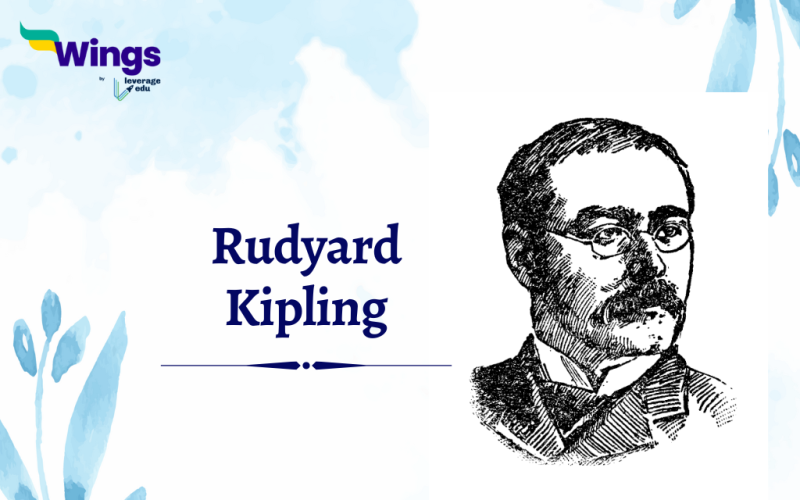Rudyard Kipling, a short-story writer, poet and novelist, is famous for his works celebrating British imperialism and his tales for children. Kipling left a significant legacy in English literature, earning the Nobel Prize for Literature in 1907. He was although critically unpopular for his opinions on the political scenarios. Charles McGrath in the New Yorker mentions – “Kipling has been variously labelled a colonialist, a jingoist, a racist, an anti-Semite, a misogynist, a right-wing imperialist warmonger; and—though some scholars have argued that his views were more complicated than he is given credit for—to some degree he really was all those things. That he was also a prodigiously gifted writer who created works of inarguable greatness hardly matters anymore, at least not in many classrooms, where Kipling remains politically toxic.” Read more to know the life history of Rudyard Kipling and his literary works.
Table of Contents [show]
| Life HIstory of Rudyard Kipling | |
| Full Name | Joseph Rudyard Kipling |
| Birth | December 30, 1865, Bombay (Mumbai), India |
| Spouse | Caroline Balestier |
| Occupation | Writer, Poet, Novelist |
| Famous Works | The Jungle Book, Kim, Just So Stories |
| Awards | Nobel Prize for Literature (1907) |
| Death | January 18, 1936, London, England, aged 70 |
Early Life and Family of Rudyard Kipling
The life history of Rudyard Kipling started in the 19th century. Born on December 30, 1865, in Bombay, India, to John Lockwood Kipling, an artist and scholar, and Alice Macdonald.
- His father later became the curator of the Lahore Museum, an institution featured in Kipling’s novel “Kim.”
- His mother, Alice, had three sisters married to influential painters and politicians of the 19th century, contributing to Kipling’s lifelong connections to influential circles.
- At the age of six, Kipling was taken to England and left at a foster home in Southsea, where he faced a difficult and unhappy childhood, which he later described in his story “Baa Baa, Black Sheep.”
- He later attended the United Services College at Westward Ho, North Devon, which he portrayed more positively in “Stalky & Co.”
Also Read: Who Is Mirza Ghalib?
Career Beginnings in India
In 1882, Kipling returned to India and worked as a journalist for seven years. His experience in India enriched his understanding of both Anglo-Indian and native-Indian life.
- Through observations, he started writing and sketching his imagination.
- He began publishing poems and stories that vividly captured these experiences, such as the verse collection “Departmental Ditties” (1886) and the short-story collection “Plain Tales from the Hills” (1888).
“I am, by calling, a dealer in words; and words are, of course, the most powerful drug used by mankind.”
― Rudyard Kipling
Kipling returned to England in 1889, where his literary reputation quickly grew. His collection “Barrack-Room Ballads” (1892), which included famous poems like “Mandalay” and “Gunga Din,” cemented his status as a leading literary figure. His marriage to Caroline Balestier in 1892 and their subsequent move to Vermont, USA, saw the creation of “The Jungle Book” (1894).
Also Read- Amrita Pritam: Life, Poems & Awards
Famous Works and Literary Contributions
Kipling’s major works span various genres and themes, reflecting his diverse talents and interests:
| Title | Year | Description |
| Plain Tales from the Hills | 1888 | A collection of stories set in British India, showcasing Anglo-Indian life. |
| The Jungle Book | 1894 | Stories of Mowgli, a boy raised by wolves, and other animal tales, celebrated for their narrative style. |
| Kim | 1901 | A novel about an Irish orphan in India, blending adventure with deep cultural insights. |
| Just So Stories | 1902 | Stories written for children, explaining various natural phenomena in a whimsical manner. |
| Puck of Pook’s Hill | 1906 | A collection of stories that blend history and fantasy, set in Sussex. |
“I always prefer to believe the best of everybody; it saves so much trouble”
― Rudyard Kipling
Later Life and Legacy of Rudyard Kipling
In 1902, Kipling bought a house in Sussex with the name “ Bateman’s”, which became his permanent home. He travelled extensively and became involved in social and political issues, particularly British imperialism. His literary output included both prose and poetry that remained popular for many years, although his reputation was later scrutinized for its imperialistic themes.
Kipling faced personal tragedies, including the death of his daughter Josephine in 1899 and his son John in World War I. Despite these losses, he continued writing and received numerous honours, including the Nobel Prize for Literature in 1907.
Kipling’s Impact
Rudyard Kipling’s works continue to be celebrated for their storytelling and vivid portrayal of British India. Despite controversies over his imperialist views, his literary contributions, especially in children’s literature and short stories, remain influential.
Rudyard Kipling’s life and work reflect the complexities of his time, capturing both the grandeur and the controversies of the British Empire through his unique literary lens. He took his last breath on 18th January 1936 and was buried at Westminster Abbey.
FAQs
Rudyard Kipling
Rudyard Kipling has a very humanistic and encouraging writing style.
The Light That Failed
Never look backwards or you’ll fall down the stairs
If
Relevant Blogs
This was all about the life history of Rudyard Kipling. If you want to know more about other Famous Personalities then visit our General Knowledge page!
 One app for all your study abroad needs
One app for all your study abroad needs















 45,000+ students trusted us with their dreams. Take the first step today!
45,000+ students trusted us with their dreams. Take the first step today!
